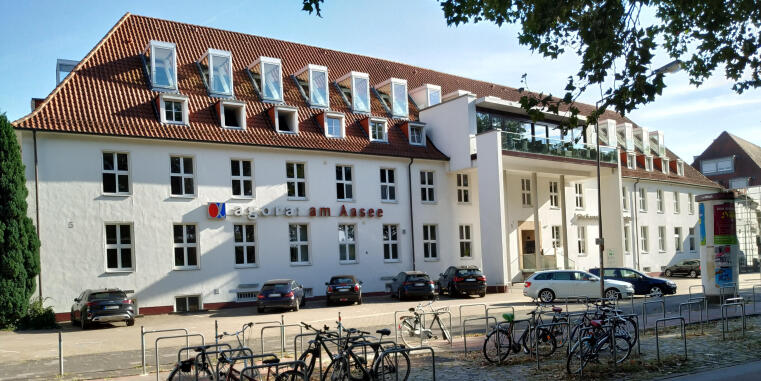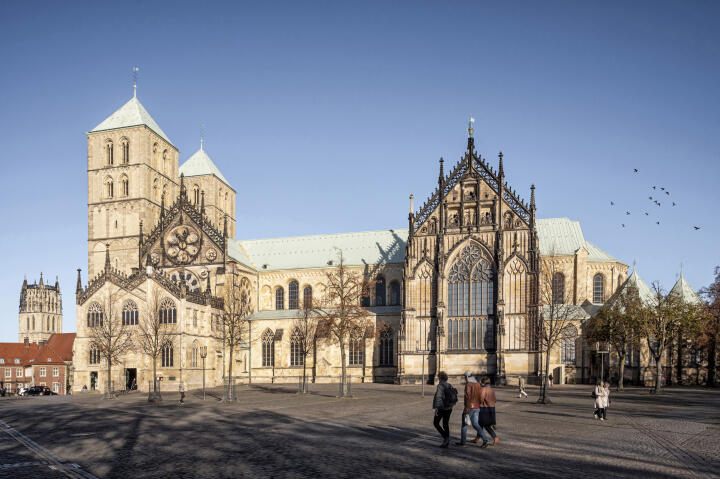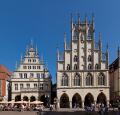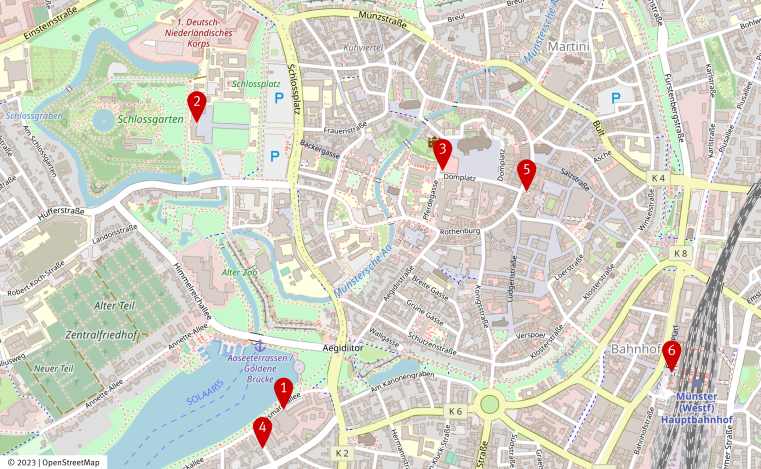

Venue
The conference will be held at the Agora conference site located near the Aasee (Lake Aa) in Münster, which is within walking distance (about 15 min) from the historic city center.
About Münster
Münster is a lively city in the north-western part of Germany with approximately 315,000 inhabitants, comprising about 65,000 students studying at various universities and academies. The largest ones are the University of Münster (Westfälische Wilhelms-Universität Münster, WWU) with about 45,000 students and the University of Applied Sciences Münster (Fachhochschule Münster) with about 15,000 students.
The city and its name date back to the foundation of a monastery in 793 by the Frisian missionary Liudger under the reign of Charlemagne. Already in the Middle Ages it became an important commercial town being part of the Hanseatic League. In the years 1643 – 1648 it hosted delegations from many European states for peace negotiations to end the wars in Europe. As a result, in January 1648 the Peace Treaty of Münster was signed ending the Eighty Years’ War between Spain and the Netherlands. The Peace of Westphalia consisting of two separate treaties was signed in October 1648 in the neighboring cities of Münster and Osnabrück to put an end to the Thirty Years’ War that had devastated large parts of Europe.
Main sights in the city of Münster include St. Paul's Cathedral (St. Paulus-Dom), built in the 13th century in a mixture of late Romanesque and early Gothic styles, housing an astronomical clock of 1540; the Prinzipalmarkt, the main shopping street in the city center with the Gothic city hall (Rathaus) built in the 14th century housing the Friedenssaal in which the Peace of Westphalia signed in 1648; St. Lambert's Church (Lambertikirche) from 1375 famous for the three cages hanging from its tower above the clock face, in which in 1535 the corpses of the executed leaders of the anabaptist rebellion in Münster were displayed; the Überwasserkirche, a Gothic hall church consecrated in 1340 and the Schloss (palace), built in 1787 by the Baroque architect Johann Conrad Schlaun as the residence for the prince-bishop, now hosting the administrative center for the University.
Münster has a large number of restaurants and cafes distributed all over the city as well as a vibrant club and pub scene. Traditional and trendy quarters to go out are – among others – the Kuhviertel in the city center and the Kreativkai located at the waterfront of the old harbour at the canal. Art on the highest level can be found at the Art Museum Pablo Picasso, the LWL Museum of Art and Culture and distributed all over the city in the form of sculptures created by world-famous artists like Henry Moore, Claes Oldenburg, Eduardo Chillida, Gerhard Richter and others. The Giant Pool Balls created in 1977 by Claes Oldenburg, for example, are located just next to the conference site.
Additional material (city guides and brochures on specific topics) can be found on the web page of the city of Münster.
Impressions of Münster


Lake Aa© Foto: Presseamt Münster / Tilman Roßmöller 
Lake Aa with "Giant Pool Balls"© Foto: Stadt Münster/Marc Geschonke 
Old Town of Münster© Foto: Stadt Münster/Patrick Schulte 
Astronomical Clock© Foto: Stadt Münster/Britta Roski 
Hall of Peace© Foto: Presseamt Münster / MünsterView 
St. Lambert's Church© Foto: Stadt Münster/Britta Roski 
© pixabay / Denny Franzkowiak 
Principal Market© Foto: Stadt Münster/Maren Kuiter 
Münster City Hall© Foto: Presseamt Münster / MünsterView 
Münster Castle© Foto: Stadt Münster / Maren Kuiter 
© T. Kuhn 
Bell Towers© Foto: Presseamt Münster / Tilman Roßmöller 
© pixabay / Makalu
Getting around!
The registration to the EDISON conference includes the Welcome!Ticket Münster which entitles participants to any number of bus and rail rides within the municipal area of Münster. It is valid from 13 - 18 August 2023 and has to be presented upon request together with a confirmation of your conference registration (e.g., your conference badge).
To reach the conference site from the main railway station (Hauptbahnhof ) you may take the busses no. 2 (direction Alte Sternwarte) or 10 (direction Mecklenbeck) to the bus stop Bismarckallee, which is just in front of the conference hall. Busses no. 2 leave at minutes 16, 36 and 56, busses no. 10 at minutes 06, 26, and 46 until about 20:30 h from bus stop C1 in front of the main railway station and the ride takes about 12 minutes. The buses pass by the city center (bus stop Domplatz).
To go back, you may use the same bus numbers with the direction Handorf from the bus stop Scharn- horststraße, which is about 4 minutes walk from the conference site in the parallel street. The busses leave at the minutes 06, 16, 26, 36, 46 and 56. If you want to go to the city center, you may leave the bus at the bus stop Aegidiimarkt (for the Domplatz) or at Picasso Museum for the Prinzipalmarkt.
To reach the Welcome reception on Sunday evening at the Schloss from the railway station you may take the busses no. 1 (direction Roxel) from bus stop B1 to Schlossplatz or no. 11 (direction Gievenbeck) from bus stop C1 to Landgericht/Schlossplatz Süd. Both are leaving at the minutes 20 and 50.
However, the central part of Münster is not very big and often walking is also an alternative. Some approximate walking times (according to Google maps) are:
- Bismarckallee - Domplatz: 11 min
- Bismarckallee - Hauptbahnhof (main station): 17 min
- Hauptbahnhof (main station) - Domplatz: 15 min
- Hauptbahnhof (main station) - Schloss: 25 min
- Domplatz - Schloss: 15 min
- Walk around the northern part of the Aasee (Lake Aa): 35 min
- Walk around the complete Aasee (Lake Aa): 1 h
Map of Münster
-
Conference site
- Agora Conference Center and Mensa, Bismarckallee 11
- Monday, 14 August, 08:30 h - Friday, 18 August, 13:00 h
-
Welcom Reception
- Schloss, Schlossplatz 2
- Sunday, 13 August, 17:00 h - 21:00 h
-
Guided walking tour of the historic city center of Münster
- Meeting point: Domplatz, in front of the LWL museum
- Tuesday, 15 August, 18:30 h
-
Conference Excursion, starting point
- Meeting point: Bus stop Körnerstraße, from the conference site turn left and then again left
- Wednesday, 16 August, 13:30 h
-
Conference Dinner
- Restaurant Ratskeller, Prinzipalmarkt 8
- Thursday, 17 August, 19:00 h
-
Main railway station, Hauptbahnhof

Travel to Münster
By air:
- The closest airport is Münster-Osnabrück (FMO) with Lufthansa flights to the hubs in Frankfurt and Munich as well as flights to some mainly European destinations. From the airport there is a regular bus service (line S50) to Münster railway station.
- Other airports with train connections to Münster are Dortmund (about 1 h by train), Düsseldorf (about 1 h 30 min by train), Cologne (about 2 h 20 min by train), and Frankfurt (about 3 h by train).
By train:
- Münster is integrated in the national and international network of Intercity (IC) and Intercity Express (ICE) trains. The central railway station is Münster (Westf) Hbf. For train connection to and from Münster please visit the web page of Deutsche Bahn.
By car:
- Münster is easily accessible via the highway network of Germany. It is located at the A1 and A43 heading from the Rhine-Ruhr area towards Bremen and Hamburg. Please note that parking in the city center may not always be easy. If you plan to arrive by car you are advised to check with the hotel whether there are parking lots available at or near the hotel.
Public transportation:
- Essentially all places in Münster can be reached by bus. An interactive network plan of the bus lines can be found at https://netzplan-muenster.de . The bus stop close to the conference site is Bismarckallee. Timetables of the bus lines can be found at here. Destinations in the surroundings of Münster can be reached either by bus or by various local and regional railway lines.

